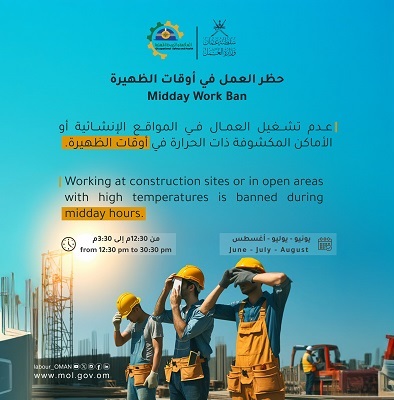
Safety measures for outdoor workers amidst rising temperature
Employee RelationsLife @ WorkOther employee benefits#HRCommunity#Wellbeing#SustainabilityForPeople
Amid rising temperatures and extreme weather conditions sweeping across the Middle East, the plight of outdoor workers has become a growing concern. The Qatar Meteorology Department has sounded the alarm with warnings of strong winds and scorching temperatures in coastal areas. Similarly, the National Center of Meteorology in the UAE has predicted temperatures soaring to 47 degrees Celsius, particularly in Abu Dhabi and Dubai, while Oman’s MET Department has issued warnings for temperatures surpassing 46 degrees Celsius nationwide.
Additionally, as the summer season sets in the Kingdom of Saudi Arabia, following a period of unpredictable weather marked by rain and sandstorms, it is imperative for government authorities and private organisations to take proactive and precautionary measures. Outdoor workers, who face the harshest impacts of these extreme conditions, urgently need protection and support. This call to action is a clarion call for ensuring their safety and well-being amidst the relentless heat.
Addressing the health risks faced by outdoor workers, the Ministry of Labour in Oman has alerted employers to strictly enforce the “midday work ban policy.” This directive mandates a halt to work on construction sites and in open areas with high temperatures during the next three months i.e. June, July, August from 12:30 p.m. to 3:30 p.m.

Similarly, suggesting employers to ensure the safety of outdoor workers by implementing preventive and precautionary measures during high temperatures, Hussein Al-Qahtani of the National Center of Meteorology, KSA, said, “Initial indicators point to extremely hot conditions during the upcoming summer season. Temperatures will rise in the eastern and central regions, while the Kingdom’s summer resort destinations are expected to receive higher than average rainfall. Various regions of Saudi Arabia have experienced weather fluctuations, including rain and sandstorms, in recent weeks.”
You may also like:
- Global workers are at risk of a ‘cocktail of health hazards' due to climate change: ILO warns in new report
- Keys to ensure sustainable success in Middle East workplaces: Tariq Ahmad
- How to resolve workplace conflicts before it's too late?
- Red flags in a workplace - Are you addressing these signs of toxic culture?
How can organisations ensure safety for their outdoor workers during these extreme weather conditions?
The human body is incapable of working under direct sun during extreme heat. To protect workers in the field, organisations can take the following precautions:
Halt work during high temperatures- In line with Oman’s 'midday work ban' policy, employers can implement measures to stop heavy work activities during high temperatures and direct exposure to the sun to prevent heat strokes, dehydration, and other health risks. Utilising real-time weather monitoring systems to send alerts during temperature spikes and hazardous conditions can be highly beneficial. Additionally, set regular intervals for rest and rehydration in shaded or air-conditioned areas.
Offer AC shuttle services - Providing transportation options for workers who need to travel to job sites can help reduce the strain of commuting in hot weather and save their energy.
Provide adequate ventilation and cooling - Ensure that workers have access to a rest area with consistent ventilation and cooling during noon hours. Setting up portable cooling stations equipped with misting fans and cold compresses at work sites also helps. Using screens or barriers to deflect direct sunlight and heat sources from work areas can further protect workers. Moreover, supply ample cool drinking water on-site and encourage frequent hydration, even before workers feel thirsty.
Optimise protective gear - Assess how uniforms and protective gear impact worker health, opting for lightweight, light-coloured, and loose-fitting options when possible. Invest in advanced, heat-resistant clothing that reflects sunlight and enhances breathability so the workers can be saved from heat stroke during the day.
Promote healthy practices - Remind workers to avoid high-caffeinated beverages and practice self-care both at work and home. Train them about the dangers of excessive heat and the signs of heat-related illnesses. Assign a trained health and safety monitor to recognise signs of heat-related illnesses and check for on-site hazards, and use a buddy system where possible.
Establish Emergency Procedures - Develop an emergency response system with the help of a workplace health and safety expert to handle heat-related incidents effectively. Provide training on the dangers of excessive heat and the signs of heat-related illnesses.









